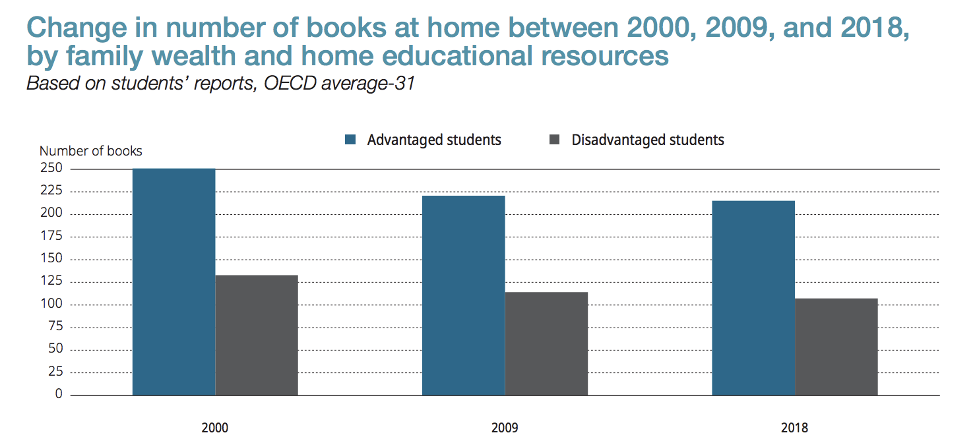[ad_1]
Strong readers who had higher scores on the PISA reading test also read on screens at home, but they tended to use their devices to gather information, such as reading the news or browsing the internet for school work. When these strong readers wanted to read a book, they opted to read in paper format or balance their reading time between paper and digital devices.
Every three years, when 600,000 students around the world take the PISA test, they fill out surveys about their families and their reading habits. Researchers at the OECD compared these survey responses with test scores and noticed intriguing relationships between books in the home, a preference for reading on paper and reading achievement. The report, “Does the digital world open up an increasing divide in access to print books?” was published on July 12, 2022.
In the United States, 31 percent of 15-year-olds said they never or rarely read books, compared with 35 percent worldwide. Meanwhile, 35 percent of American students said they primarily read paper books, almost matching the international average of 36 percent. Another 16 percent of Americans said they read books more often on screens and 18 percent responded that they read books equally on both paper and screens.
Digital books have become extremely popular among students in some regions of Asia, but students who read books on paper still outperformed even in cultures where digital reading is commonplace. More than 40 percent of students in Hong Kong, Indonesia, Malaysia, Taiwan and Thailand reported reading books more often on digital devices. Yet in Hong Kong, Malaysia and Taiwan, students who read books mostly on paper or read in both formats scored higher than those who primarily read digital books. Both Thailand and Indonesia were exceptions; digital readers did better. Hong Kong and Taiwan are two of the highest performing education systems in the world and even after adjusting for students’ socioeconomic status, the advantage for paper reading remained pronounced.
Teens around the world are rapidly turning away from reading, according to OECD surveys. Fifteen-year-olds are reading less for leisure and fewer fiction books. The number of students who consider reading a “waste of time” jumped by more than 5 percentage points. Simultaneously, reading performance around the world, which had been slowly improving up until 2012, declined between 2012 and 2018. Across OECD countries that participated in both assessments, reading performance fell back to what it had been in 2006.
OECD researchers wonder if the presence of physical books at home still matters in the digital age. In the student surveys, students were told that each meter of shelving typically holds 40 books and were asked to estimate the number of books in their homes. Both rich and poor students alike reported fewer books in the home over the past 18 years, but the book gap between the two remained persistently large with wealthier students living amid twice as many books as poorer students.

The influence of books at home is a bit of a chicken-egg riddle. The OECD found that students who had more books at home reported that they enjoyed reading more. Logically, students who are surrounded by physical books may feel more encouraged by their families and inspired to read. But it could be that students who enjoy reading receive lots of books as presents or bring more books home from the library. It’s also possible that both are true simultaneously in a virtuous two-way spiral: more books at home inspire kids to read and voracious readers buy more books.
OECD researchers are most worried about poorer students. Low-income students made huge strides in access to digital technology well before the pandemic. Ninety-four percent of students from low-income families across 26 developed nations had access to the internet at home in 2018, up from 75 percent in 2009. “While disadvantaged students are catching up in terms of access to digital resources, their access to cultural capital like paper books at home has diminished,” the OECD report noted.
As one gap closes, another one opens.
[ad_2]
Source link

